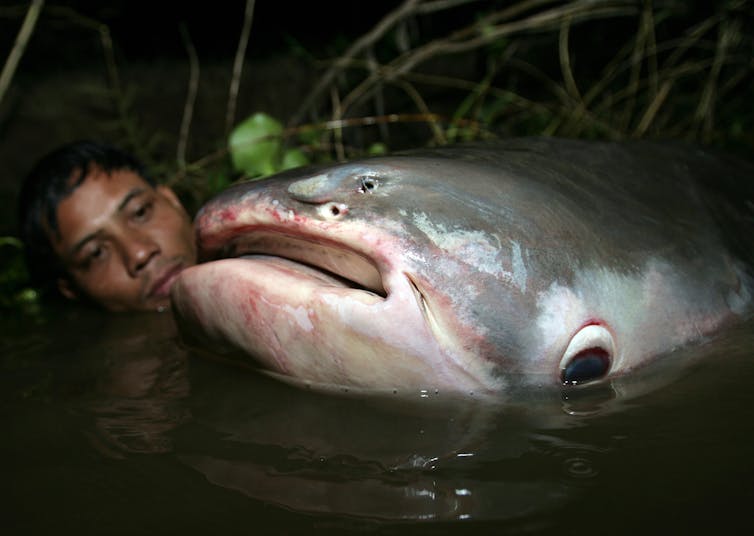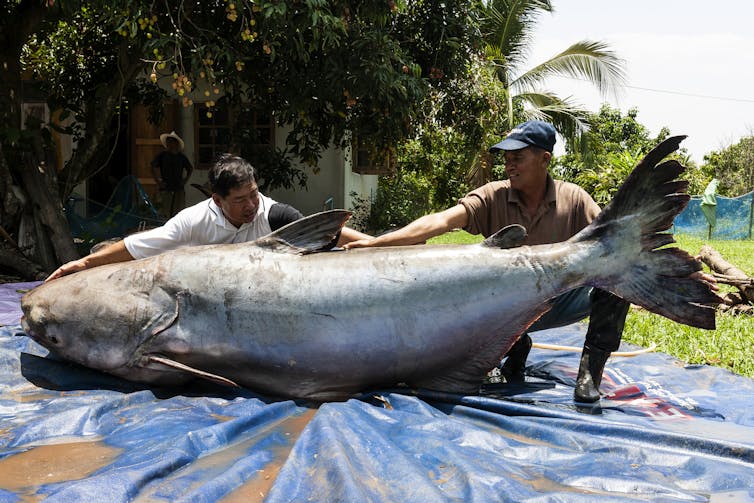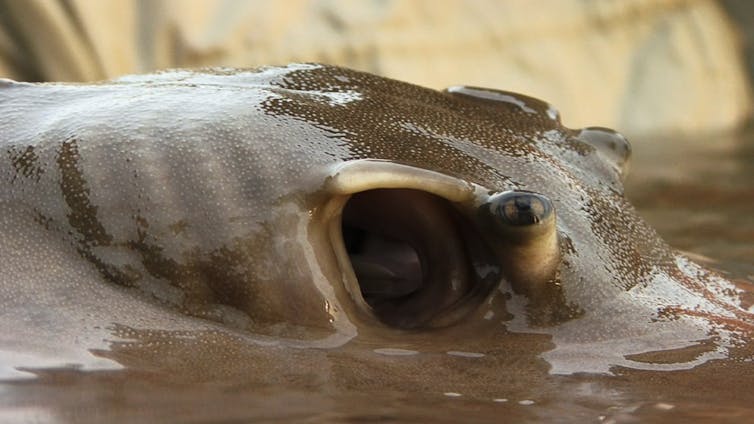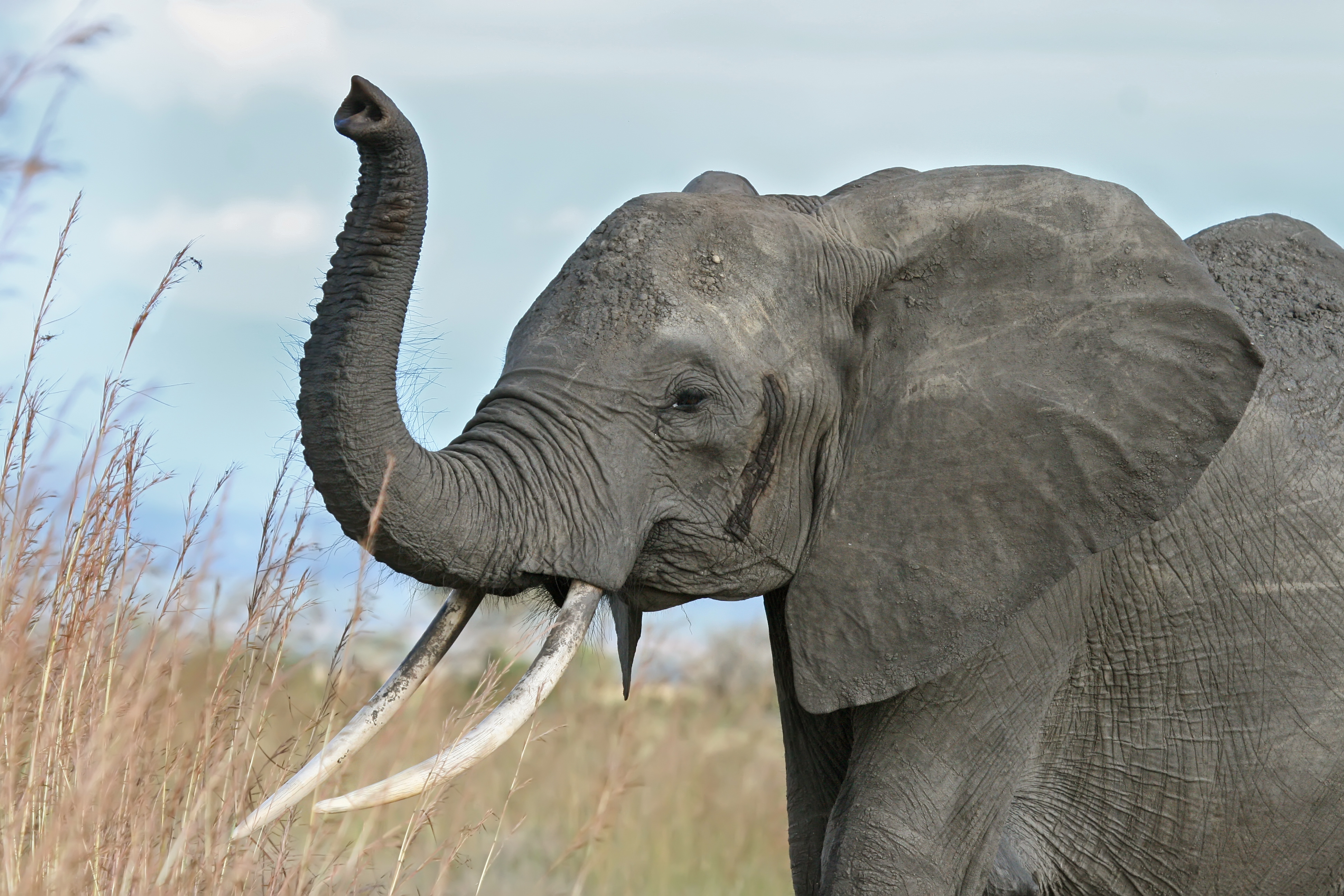
Rivers have been the lifeblood of human civilization throughout history, and yet we know surprisingly little about what lives in many of them – including the giant creatures that prowl their depths.
While we know the biggest animal in the ocean is the blue whale and the largest marine fish is the whale shark, the identity of the world’s largest freshwater fish species long remained a mystery.
Until 2022, that is, when fishers in Cambodia caught a giant freshwater stingray in the remote reaches of the Mekong River.
Weighing an astounding 661 pounds, the stingray surpassed by 15 pounds a giant catfish caught in Thailand in 2005 that had previously been considered the unofficial record holder.
The discovery marked a milestone in fish biologist Zeb Hogan’s more than two-decade quest to study and protect giant freshwater fish. As a group, these megafish are among the most endangered animals on the planet.
Before releasing the female ray back into the river, Hogan’s research team put an acoustic tracker on her. She has been sending back clues about stingrays’ elusive behavior ever since.
Colossal catfish and gargantuan gars
In a new book, “Chasing Giants: In Search of the World’s Largest Freshwater Fish,” Hogan and I tell the troubling story of the 30 or so fish species that live exclusively in rivers and lakes and can grow to more than 200 pounds or at least 6 feet (1.8 meters) long.
Found on all continents except Antarctica, they are a wonderfully weird bunch of creatures, from colossal catfish and carp to gargantuan gars.

But freshwater vertebrate populations have declined over the past five decades at twice the rate experienced by species within terrestrial or marine ecosystems. Megafish numbers in particular fell by a shocking 94%, according to one study of more than 200 large freshwater species.
One of the largest species, the Chinese paddlefish, is believed to have gone extinct sometime in the 2000s. “This is a fish that had been on Earth for more than 100 million years before disappearing in a flash,” says Hogan, who used to host National Geographic’s “Monster Fish” television show and now leads a University of Nevada, Reno, research project I am involved with called Wonders of the Mekong, supported by the U.S. Agency for International Development.

The importance of very large fish to freshwater ecosystems has been woefully understudied. Many giant freshwater fish are apex predators that can have profound effects on the ecosystems in which they live by keeping their prey populations in check and maintaining biodiversity.
What’s killing off the megafish
The decline of giant freshwater fish is due to human impacts, such as overfishing, dam building and climate change.
Large fish are disproportionately targeted by fishing. Since many of these species are slow to mature, they may never reach the age to reproduce. Dam building is another major threat, because large fish often need to make long migrations to complete their life cycles, and a new dam can block their migration paths.

In the Mekong, where more giant fish species are found than in any other river, climate change is causing more severe droughts and disrupting the monsoon seasons that govern the river’s essential flood regime.
There are signs that interest in freshwater species is gaining momentum, including increasing calls to explicitly include freshwater ecosystems in the 30×30 initiative, a global effort to set aside 30% of land and sea area for conservation by 2030. So far, however, conservation efforts to protect endangered giant freshwater fish species are mostly regional.
Alligator gars and sturgeon make a comeback
Although the outlook for most giant fish remains grim, some species, like the air-breathing arapaima in South America, may be bucking the trend.
The arapaima, a torpedo-shaped giant that can grow to lengths of more than 12 feet, has long been overharvested by fishers in the Amazon, where it’s known as the Amazonian cod. But stricter fishing regulations introduced by Indigenous communities appear to have led to populations’ rebounding in many places.

In the United States, the alligator gar, another air-breathing megafish, was once largely considered a “trash fish” thought to devour game fish, so it was systematically exterminated from much of its southern range. But then scientists began to study the species and found it was an important contributor to ecosystem functions. Today, alligator gar populations have bounced back in rivers like the Trinity in Texas.
A similar case involves the lake sturgeon, one of the few true freshwater sturgeons, whose populations in Wisconsin have benefited from long-term conservation efforts and science-driven management that includes strictly regulated seasonal recreational fishing.
Protecting the giants of the Mekong
Back in Cambodia, our Wonders of the Mekong project is raising public awareness about the plight of the megafish, and we are working closely with local fishers to encourage them to protect threatened species.
In an example of those efforts’ paying off, fishers in early 2023 caught a Mekong giant catfish weighing more than 200 pounds. Instead of killing it and selling the meat for a sizable profit, the fishers decided to release the fish in an elaborate ceremony in which it was sprinkled with flowers before it was let go.

In recent months, our project has also reintroduced into the Mekong rare giant catfish that were captured as young fish and raised in Cambodia, and giant barb, another critically endangered megafish species that historically has grown to 600 pounds.
While giant freshwater stingray numbers have plummeted in other parts of its native Southeast Asian range, the population appears to be relatively robust in the upper stretches of the Mekong River in Cambodia where the record ray was discovered. Data collected from that female, and reported in a study I co-authored, shows it is staying in much the same location, leading researchers to believe the area could be an important refuge for the stingrays and possibly other megafish.

Long-standing plans by the Cambodian government to build two large dams on this section of the river appear to have been scrapped, at least for now. At the end of 2022, the government instead put forth a proposal to turn the biodiverse stretch of the river, which is also home to a critically endangered population of Irrawaddy river dolphins, into a UNESCO World Heritage site.
While the record stingray is big, it might not be the largest of this species of ray in the Mekong. Local fishers speak of rays growing up to 200 pounds heavier.
It’s also possible the giant stingray is not the largest freshwater fish species. Research on the arapaima, for example, suggests it could grow as big, or even bigger, in places like Guyana. But, as Hogan says, “It’s not about finding the biggest fish. It’s about learning more about these amazing creatures to figure out how to better protect them.”
Stefan Lovgren, Research Scientist in River Ecosystems, University of Nevada, Reno
This article is republished from The Conversation under a Creative Commons license. Read the original article.











